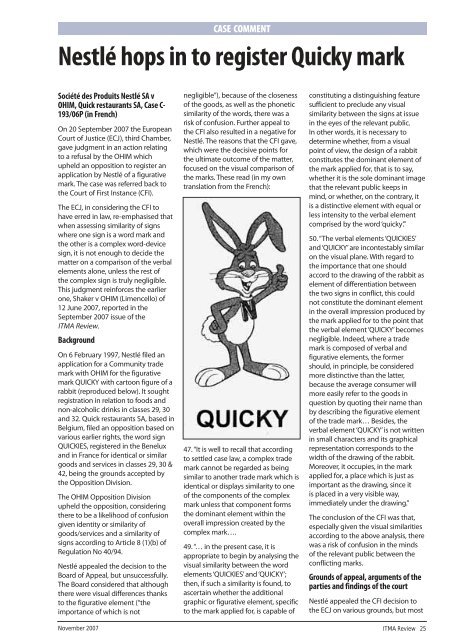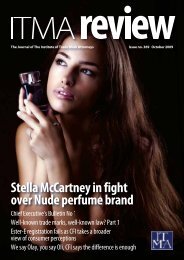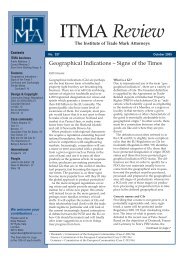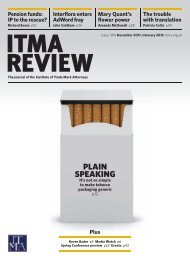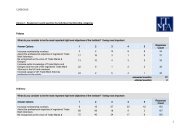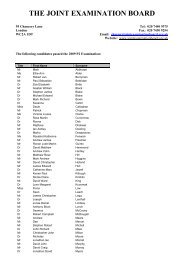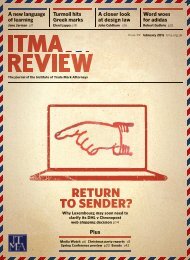ITMA Autumn Conference: Treviso provides cultured backdrop for ...
ITMA Autumn Conference: Treviso provides cultured backdrop for ...
ITMA Autumn Conference: Treviso provides cultured backdrop for ...
You also want an ePaper? Increase the reach of your titles
YUMPU automatically turns print PDFs into web optimized ePapers that Google loves.
Société des Produits Nestlé SA v<br />
OHIM, Quick restaurants SA, Case C-<br />
193/06P (in French)<br />
On 20 September 2007 the European<br />
Court of Justice (ECJ), third Chamber,<br />
gave judgment in an action relating<br />
to a refusal by the OHIM which<br />
upheld an opposition to register an<br />
application by Nestlé of a figurative<br />
mark. The case was referred back to<br />
the Court of First Instance (CFI).<br />
The ECJ, in considering the CFI to<br />
have erred in law, re-emphasised that<br />
when assessing similarity of signs<br />
where one sign is a word mark and<br />
the other is a complex word-device<br />
sign, it is not enough to decide the<br />
matter on a comparison of the verbal<br />
elements alone, unless the rest of<br />
the complex sign is truly negligible.<br />
This judgment rein<strong>for</strong>ces the earlier<br />
one, Shaker v OHIM (Limencello) of<br />
12 June 2007, reported in the<br />
September 2007 issue of the<br />
<strong>ITMA</strong> Review.<br />
Background<br />
On 6 February 1997, Nestlé filed an<br />
application <strong>for</strong> a Community trade<br />
mark with OHIM <strong>for</strong> the figurative<br />
mark QUICKY with cartoon figure of a<br />
rabbit (reproduced below). It sought<br />
registration in relation to foods and<br />
non-alcoholic drinks in classes 29, 30<br />
and 32. Quick restaurants SA, based in<br />
Belgium, filed an opposition based on<br />
various earlier rights, the word sign<br />
QUICKIES, registered in the Benelux<br />
and in France <strong>for</strong> identical or similar<br />
goods and services in classes 29, 30 &<br />
42, being the grounds accepted by<br />
the Opposition Division.<br />
The OHIM Opposition Division<br />
upheld the opposition, considering<br />
there to be a likelihood of confusion<br />
given identity or similarity of<br />
goods/services and a similarity of<br />
signs according to Article 8 (1)(b) of<br />
Regulation No 40/94.<br />
Nestlé appealed the decision to the<br />
Board of Appeal, but unsuccessfully.<br />
The Board considered that although<br />
there were visual differences thanks<br />
to the figurative element (“the<br />
importance of which is not<br />
November 2007<br />
CASE COMMENT<br />
Nestlé hops in to register Quicky mark<br />
negligible”), because of the closeness<br />
of the goods, as well as the phonetic<br />
similarity of the words, there was a<br />
risk of confusion. Further appeal to<br />
the CFI also resulted in a negative <strong>for</strong><br />
Nestlé. The reasons that the CFI gave,<br />
which were the decisive points <strong>for</strong><br />
the ultimate outcome of the matter,<br />
focused on the visual comparison of<br />
the marks. These read (in my own<br />
translation from the French):<br />
47. “It is well to recall that according<br />
to settled case law, a complex trade<br />
mark cannot be regarded as being<br />
similar to another trade mark which is<br />
identical or displays similarity to one<br />
of the components of the complex<br />
mark unless that component <strong>for</strong>ms<br />
the dominant element within the<br />
overall impression created by the<br />
complex mark….<br />
49. “… in the present case, it is<br />
appropriate to begin by analysing the<br />
visual similarity between the word<br />
elements ‘QUICKIES’ and ‘QUICKY’;<br />
then, if such a similarity is found, to<br />
ascertain whether the additional<br />
graphic or figurative element, specific<br />
to the mark applied <strong>for</strong>, is capable of<br />
constituting a distinguishing feature<br />
sufficient to preclude any visual<br />
similarity between the signs at issue<br />
in the eyes of the relevant public.<br />
In other words, it is necessary to<br />
determine whether, from a visual<br />
point of view, the design of a rabbit<br />
constitutes the dominant element of<br />
the mark applied <strong>for</strong>, that is to say,<br />
whether it is the sole dominant image<br />
that the relevant public keeps in<br />
mind, or whether, on the contrary, it<br />
is a distinctive element with equal or<br />
less intensity to the verbal element<br />
comprised by the word ‘quicky’.”<br />
50. “The verbal elements ‘QUICKIES’<br />
and ‘QUICKY’ are incontestably similar<br />
on the visual plane. With regard to<br />
the importance that one should<br />
accord to the drawing of the rabbit as<br />
element of differentiation between<br />
the two signs in conflict, this could<br />
not constitute the dominant element<br />
in the overall impression produced by<br />
the mark applied <strong>for</strong> to the point that<br />
the verbal element ‘QUICKY’ becomes<br />
negligible. Indeed, where a trade<br />
mark is composed of verbal and<br />
figurative elements, the <strong>for</strong>mer<br />
should, in principle, be considered<br />
more distinctive than the latter,<br />
because the average consumer will<br />
more easily refer to the goods in<br />
question by quoting their name than<br />
by describing the figurative element<br />
of the trade mark… Besides, the<br />
verbal element ‘QUICKY’ is not written<br />
in small characters and its graphical<br />
representation corresponds to the<br />
width of the drawing of the rabbit.<br />
Moreover, it occupies, in the mark<br />
applied <strong>for</strong>, a place which is just as<br />
important as the drawing, since it<br />
is placed in a very visible way,<br />
immediately under the drawing.”<br />
The conclusion of the CFI was that,<br />
especially given the visual similarities<br />
according to the above analysis, there<br />
was a risk of confusion in the minds<br />
of the relevant public between the<br />
conflicting marks.<br />
Grounds of appeal, arguments of the<br />
parties and findings of the court<br />
Nestlé appealed the CFI decision to<br />
the ECJ on various grounds, but most<br />
<strong>ITMA</strong> Review 25


